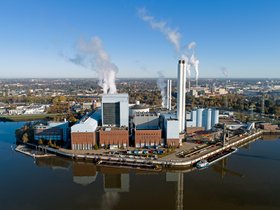Fossil-free energy from waste heat
TU expert Arne Speerforck on the realization of an aquifer heat storage facility for Hamburg's Tiefstack energy park
17.02.2023

As Hamburg's last combined heat and power plant, Tiefstack is to be replaced by various climate-neutral heating solutions by 2030 at the latest. The move away from coal is to be achieved, among other things, with an underground heat storage facility. Professor Arne Speerforck and his team at Hamburg University of Technology are investigating its implementation as part of the North German Reallabor (NRL), Germany's largest joint project for the energy transition. In an interview, the energy engineer explains what lies behind the new technology and why he believes the planned measures are sensible and right.
How does a seasonal aquifer heat storage facility work?
An aquifer storage facility is an underground reservoir that takes in, holds and can release thermal energy. It involves pumping thermal water from a naturally occurring, water-bearing and porous rock layer to the surface and heating it with waste heat from an industrial or waste incineration plant. The hot water is then pumped back into the ground where it is stored. If necessary, it can be pumped up again. In this way, CO2-neutral energy can be provided for the winter months.
What is your task in implementing the heat storage facility at the Tiefstack site?
My colleagues and I are investigating how the aquifer storage facility can be operated as energy-efficiently and CO2-free as possible. This concerns both the operation of heat pumps, which ensure the desired temperature in the district heating system if the aquifer storage alone is not sufficient for this, and the integration of the aquifer storage into district heating systems. For this purpose, we create detailed models that are validated using various measured values. With the help of this overall system model, operational and economic optimization potentials of aquifer storage facilities at other locations can be investigated.
Since the war in Ukraine, the call for independent energy sources has become louder and louder. Could aquifer heat storage be the solution for Germany?
Especially for heating networks or neighborhoods, these storage facilities could be a good alternative to break away from oil or natural gas as energy sources. However, not as a stand-alone measure. Different soils do not allow aquifer storage to be used equally well everywhere. In Hamburg, for example, an aquifer storage facility will not be developed until it is more than 1,000 meters deep, for both legal and geological reasons. Factors such as a very high salt content of the thermal water and the associated corrosion can also make operation more difficult and thus also have an impact on economic efficiency. It will therefore depend on the interplay of several storage technologies.
In terms of climate protection, the new technology has a good reputation. How do you assess that, taking wind and solar energy into account?
Wind and solar energy are not geared to consumer demand. The demand for electricity for lighting and heating is particularly high in winter, but at the same time, calm winds and short periods of the day mean that photovoltaic and wind power plants produce very little electricity. An aquifer storage system could store excess electricity from the summer months in the form of thermal energy. In Hamburg, however, the initial plan is only to use waste heat from year-round processes to take advantage of existing heat sources. It is therefore a seasonal heat storage system. However, this alone would make processes more energy-efficient and enable more sustainable operations. This is already a significant contribution to climate protection.
In addition to Arne Speerforck, environmental engineer Kerstin Kuchta and energy engineer Christian Becker from Hamburg Technical University are also conducting research on the NRL's joint project. Together with 50 companies, institutions and research facilities, they are developing solutions to eliminate the use of carbon-based raw materials, reduce energy consumption and reliably use renewable energies. For more information, visit www.norddeutsches-reallabor.de.
TUHH - Public Relations Office







